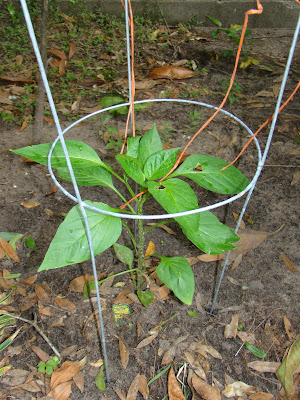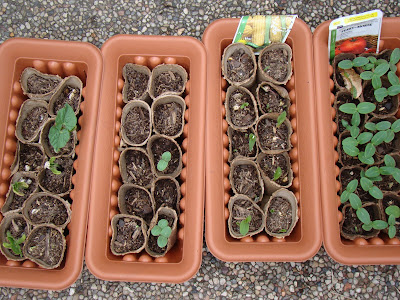
above - key lime trees (well, not trees yet) they have big thorns all over it. Limes are great for seasoning, and limonaid.
Yes, it is in our front yard, (mailbox post can be seen) Lawns are silly though... Think I can talk Doug into a beautiful flowering edible landscape?
http://www.youtube.com/watch?v=X_4LMoaCVFA

seeds from an orange from the grocery store the kids planted. It is growing, I don't know that it will ever produce fruit, but you never know...

bell pepper

Avacado (again, planted from a pit from the store a few years ago, now about 4' tall) We will see if it ever grows an avacado. Kent sad the leaves on this are poisonous...

strawberries. Yummmm!

Basil. I planted basil here last year, and it did really well. Basil is one of our favorite herbs.

The kids just planted this little strip next to the driveway with some random starter plants we had. the tags were taken off, so I don't know what they will be. Hopfully they will survive here.

rasberries! Just planted this spring, and they are growing like crazy, wish I would have gotten a few more plants. Already producing fruit. right next to the pool so we can eat and swim :)

starter plants in plantable containers. You just plant the whole container in the ground, and the roots grow through it. I got these little ones from the dollar store (36 for a dollar) but there are some free ones - Shannon uses toilet paper rolls as starter containers. see:
http://www.yougrowgirl.com/thedirt/2007/04/13/toilet-roll-seed-starter/
Also can use egg cartons, egg shells, lots of containers that we usually throw away can be sed as starters, then plant the whole thing, composts as it grows.
composting is another big gardening area to get into:
http://www.youtube.com/watch?v=aKlauRA7ugI
Put a little bucket in your kitchen, save all the organic stuff (rinds, cardboard, apple cores, etc. etc.) and make your own fertilizer while decreasing your garbage.

Green beans next to fence - we dragged the lattice over to the corner for the vines to grow up.

corn already coming up! Planted this a week? ago.

tomatoes with wire cages. See "vertical gardening"
In small areas, instead of planting plants far apart, you can let them grow up instead of out, making better use of gardening space:
http://www.youtube.com/watch?v=Yra0g5uOXhQ

Cilantro

cucumbers - also going to try vertical gardening. Should keep the cucumbers off the ground, better for getting insects off.
Repel Insects: from
http://www.sheridannurseries.com/GardenSite/subGARDENTIP25mainframe.htm#REPELINSECTS
Plants That Naturally Repel Insects:
There are many beneficial herbs that keep insects away. Peppermint repels ants, white cabbage moth, aphids, and flea beetle. Since Mint is a notorious spreader that can easily get out of control establish it in pots that are above ground or sunk below where roots can't escape drainage holes. Garlic discourages aphids, flea and Japanese beetle, and spider mites. Perennial Chives repel aphids and spider mites, two very common garden pests. Chives are often planted among roses to keep aphids away and to resist the disease, Blackspot. Basil drives away flies and mosquitoes. Borage deters that monster of vegetable garden insects, the tomato hornworm. Rosemary and Sage repel cabbage moth, bean beetles, and carrot flies.
Annual Marigolds can be used anywhere to deter Mexican bean beetle, squash bug, thrips, tomato hornworm, and whitefly. They are also known to repel harmful root knot nematodes (soil dwelling microscopic white worms) that attack tomatoes, potatoes, roses, and strawberries. The root of the Marigold produces a chemical that kills nematodes as they enter the soil. If a whole area is infested, at the end of the season, turn the Marigolds under so the roots will decay in the soil. You can safely plant there again the following spring. Nasturtium is another annual, in this case a trailing vine, that keeps away Colorado potato bug, squash bug, and whitefly.
The perennial, Artemisia or Wormwood, deters slugs that are so devastating to foliage. Radish can be planted to discourage cucumber beetle, squash bug, and stink bug
***Ideal Planting Companions For Vegetables:***
The following is a list of vegetables and their ideal planting companions, plus combinations to avoid:
*Beans-like celery and cucumbers but dislike onions and
fennel.
*Beets are compatible with bush beans, lettuce, onions, kohlrabi, and most members of the cabbage family. Keep pole beans and mustard away from them.
*Cabbage, celery, dill, onions, and potatoes are good companion plants. Dislikes include strawberries, tomatoes, and pole beans.
*Carrots, lettuce, radish, onions, and tomatoes are friends. Dill isn't, so plant it at the other end of the garden.
*Corn prefers to be near pumpkins, peas, beans, cucumbers, and potatoes. Keep tomatoes away.
*Cucumbers like sweet corn, peas, radishes, beans, and sunflowers. Dislikes include aromatic herbs and potatoes.
*Lettuce grows especially well with onions. They are also compatible with strawberries, carrots, radishes, and cucumbers.
*Onions can be planted near lettuce, beetroot, strawberries, and tomatoes but keep well away from peas and beans.
*Peas, carrots, cucumbers, sweet corn, turnips, radishes, beans, potatoes, and aromatic herbs are good companions. Keep peas away from onions, garlic, leek, and shallots.
*Radish grows well with beetroot, carrots, spinach, parsnip, cucumbers, and beans. Avoid planting near cabbage, cauliflower, Brussels sprouts, broccoli, or turnips.
*Squash can be planted with cucumbers and corn.
*Tomatoes, carrots, onions, and parsley are good companion plants. Basil improves growth and flavour. Keep cabbage and cauliflower away from them.
***Attracting Good Insects To Your Garden:
Plant certain vegetables, herbs, or flowers in your garden to attract predatory insects that will feed on the harmful, undesirable ones. Perennial Yarrow, for example attracts ladybugs that consume masses of aphids. The lacewing that feeds on aphids, mealybugs, mites, and scale needs lots of pollen from flowers and evergreens for shelter. Wasps and bees are also beneficial to the garden. Even the prehistoric-looking preying mantis is a friend, so don't discourage it from visiting.
When you create a natural balance in your garden you'll discover how much better everything grows and you won't need to worry about damaging the environment

This is the garden corner of the yard. Just looks like dirt from a distance, but up close, stuff is starting to grow!

Banannas (or plantains) We get a few each year, have never tried to eat them to. This year might be the one where we try to fry some up.

Our apple tree - just planted, popped out leaves, and one little apple already (see green apple in foreground) This is a special variety that requires fewer chilling hours (most apple trees require going through a winter chilling in order to produce fruit)

pineapple - looks like we might get a fruit this year! If you get a pineapple at the store, don't throw the top away - plant it. Putting an apple core in the center of the plant encourages it to fruit.
http://www.youtube.com/watch?v=fCjE7SPbzzM&feature=related

random starter plant - forget what they are:) I might leave some stuff in containers on the cement porch - planter gardening.
http://www.youtube.com/watch?v=dVxZGUHUcHM
We have some in our warde who drag their pots around every day to get the maximum sun exposure. It it also good for plants who need good drainage. (put rocks in the bottom, hole, get drainage)

tomato

rosemarry, lemon ??? a couple different herbs.

Other preserving food stuff:
Freezing
ever tried freezer dinners? Saves a lot of time cooking. (Oncew a month cooking)
http://www.dinnersinthefreezer.com/
Everyone is familiar with canning
canning
http://www.storeitfoods.com/page/canning_videos
This book has some other things, using oils / vinegars / salts / sugars, Alcohol, and lactic fermentation. It goes through methods that preserve without nutrient loss, has a big table in the back that highlights which methods work for which foods, another ancient tradition that is being lost, and should not be.
- stuffed Sun dried tomatoes in oil
- Rose petal salt potpourri
- herbs in oil (season oil)
- Melon Mint Marmalade and other Jams/Jellies
- Sweet and Sour cherries in vinegar
Marc and Shannon have a solar cooker that is great in the summer. Keeps the house cool by not cooking in doors, free energy, and gives a nice even heat. They also do drying.
Food preservation:
Solar Cooking and Food Drying and Solar Stills and Root Cellars
http://www.builditsolar.com/Projects/Cooking/cooking.htm
**********WATER - Need water?
*Water barrels
http://www.youtube.com/watch?v=MGFDlkJOdaM
***re-using grey water to garden ;)
Rethinking Water: Greywater Guerillas Workshop
http://www.youtube.com/watch?v=sFpiO92laMA
***grey water:
- Use the rinse water from your dishes (if you do them by hand) for rinsing the leaves on your plants to repel pests. I just put it in spray bottles; it makes it easier to get the water on the plants. The soap in the water repels bugs.
- The tea leaves that are left over from your morning cup of tea contain nitrogen. Spread them over the soil around your plants and work them into the dirt a little bit, the plants will thank you for it! Also coffee grounds if you drink it.
- Any left over club soda that has gone flat in the bottom of the bottle, can provide extra minerals that your plants need.
- Left over water from cooking pasta, potatoes or eggs provides extra nutrients to your garden.
-
***Dig your own well in your backyard!
http://www.youtube.com/watch?v=FbGUV7GQpMM&feature=related
**Water Storage:
Save your used plastic bottles (2liter, milk, juice) and fill them with wwater. Place the water containers on the ground between rows of growing plants in the spring and fall. During the day the water soaks up heat. During the night, the bottles give off heat keeping the ground around them warm during frost seasons.
random stuff:
onions drive away insects – and other helpful plants
bottle bug trap:
Any left over beer from a celebration can be poured into a bowl and placed in the garden with the lip just slightly raised above the ground; the slugs love this stuff and will stay off your plants! Earwigs will also be attracted to containers that are filled with vegetable oil and beer. Honey works, as does other sweet substances. If you want to trap them once they get in, make a little funnel at the top, get in, can't climb up the sides to get back out. Works inside too...
And if you are not into gardening, check out the local farmer’s markets, and local farms. Get fresh produce from somewhere other than the grocery store, and play around with various food preservation techniques. Fun stuff!

Harvesting seeds / seed saving
This book came recommended to me by someone who does this stuff. Most farmers now use hybrid plants that are engineered to produce more fruit, unfortunately, these plants do this by not producing seeds. The hybrid plants put all their energy into making food rather than reproducing. This is potentially very dangerous, if our seed supply runs out, our food runs out. Hybrid plants are taking over farms, killing off non-hybrid varieties. We are losing variety, losing ability to keep growing food, and losing the ancient tradition / work of generations of farmers who painstakingly hand-picked seeds from the best plants.
Harvesting seeds / buying heirlooms:
- year by year seeds/plants develop resistances to local weather/insects/diseases. Create your own seeds best for your own area.
- self-perpetuating garden (bypass garden seed industry)
- unique foods not found in grocery store
- creating your own new species through cross pollination
- rescue non-hybrid varieties (that have been preserved for generations) from becoming extinct.
This book goes through – pollination of different types (self-pollinated/insect pollinated/wind pollinated/hand pollinated). Purity - isolation distances between plants to give “pure seeds” that are not cross pollinated. Seed cleaning/drying/storage/harvesting. Pictures / info on most vegetable families.
Obviously creating heirloom seeds is serious business with lots to learn and years to really get it going, but it looks like it could be a fun hobby.
OK,OK, that was prob too much info. Happy Spring everyone!